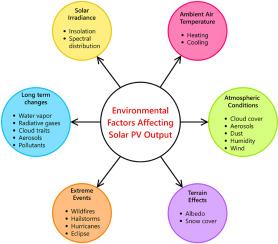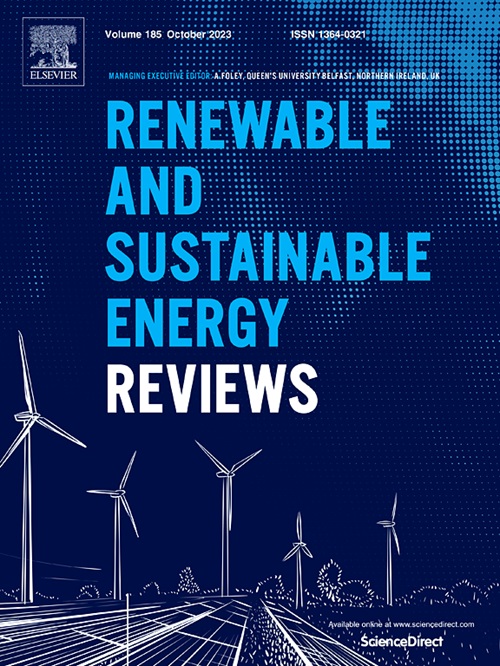The environmental factors affecting solar photovoltaic output
IF 16.3
1区 工程技术
Q1 ENERGY & FUELS
引用次数: 0
Abstract
The global expansion of solar photovoltaics (PV) is central to the global energy transition. As governments aim to triple renewable energy capacity by 2030, solar PV is poised for rapid growth, particularly outside mid-latitude regions (China, Europe, US) where uptake has been highest. These new growth areas have diverse environmental conditions, where factors like higher temperatures and aerosol concentrations strongly impact solar power production. A comprehensive review of these effects therefore aids PV performance and siting optimization. This review examines six key influences: solar irradiance, ambient temperature, atmospheric conditions, terrain effects, extreme weather events, and long-term irradiance changes. First, solar irradiance has strong geographic and temporal variability, making it the most significant factor. Second, raising module temperature reduces efficiency by 0.4–0.5 % per degree Celsius, limiting productivity in hotter climates. Third, atmospheric conditions (clouds, aerosols, pollutants, and dust) can reduce electricity output by up to 60 %, especially in desert regions. Fourth, terrain factors like albedo and snow present mixed effects, with increased reflection boosting output but snow obstructing panels. Fifth, extreme weather like wildfires and hailstorms cause substantial damage, while solar eclipses lead to large but short-lived output losses. Finally, long-term changes in solar irradiance, driven by climate change and air pollutants, present future challenges for maintaining PV efficiency. Optimizing PV systems for diverse climates and mitigating environmental impacts on productivity is important to the continued success of solar photovoltaics. This review highlights the need for tailored strategies to maintain performance in varied and evolving environmental contexts.

影响太阳能光伏发电输出的环境因素
太阳能光伏发电(PV)在全球的发展是全球能源转型的核心。由于各国政府的目标是到 2030 年将可再生能源发电量增加两倍,太阳能光伏发电将实现快速增长,尤其是在中纬度地区(中国、欧洲、美国)以外的地区,这些地区的太阳能光伏发电量最高。这些新增长地区的环境条件各不相同,较高的温度和气溶胶浓度等因素对太阳能发电产生了强烈影响。因此,全面审查这些影响有助于光伏性能和选址优化。本综述探讨了六个关键影响因素:太阳辐照度、环境温度、大气条件、地形影响、极端天气事件和长期辐照度变化。首先,太阳辐照度具有很强的地理和时间变化性,因此是最重要的影响因素。其次,模块温度每升高 1 摄氏度,效率就会降低 0.4-0.5%,从而限制了炎热气候条件下的生产率。第三,大气条件(云层、气溶胶、污染物和灰尘)可使发电量减少高达 60%,尤其是在沙漠地区。第四,反照率和积雪等地形因素会产生混合影响,反射增加会提高产量,但积雪会阻碍太阳能电池板。第五,野火和冰雹等极端天气会造成巨大损失,而日食会导致大量但短暂的输出损失。最后,在气候变化和空气污染物的影响下,太阳辐照度会发生长期变化,这对维持光伏发电效率提出了挑战。针对不同气候优化光伏系统,减轻环境对生产力的影响,对于太阳能光伏技术的持续成功非常重要。本综述强调了在不同和不断变化的环境背景下保持性能的定制战略的必要性。
本文章由计算机程序翻译,如有差异,请以英文原文为准。
求助全文
约1分钟内获得全文
求助全文
来源期刊

Renewable and Sustainable Energy Reviews
工程技术-能源与燃料
CiteScore
31.20
自引率
5.70%
发文量
1055
审稿时长
62 days
期刊介绍:
The mission of Renewable and Sustainable Energy Reviews is to disseminate the most compelling and pertinent critical insights in renewable and sustainable energy, fostering collaboration among the research community, private sector, and policy and decision makers. The journal aims to exchange challenges, solutions, innovative concepts, and technologies, contributing to sustainable development, the transition to a low-carbon future, and the attainment of emissions targets outlined by the United Nations Framework Convention on Climate Change.
Renewable and Sustainable Energy Reviews publishes a diverse range of content, including review papers, original research, case studies, and analyses of new technologies, all featuring a substantial review component such as critique, comparison, or analysis. Introducing a distinctive paper type, Expert Insights, the journal presents commissioned mini-reviews authored by field leaders, addressing topics of significant interest. Case studies undergo consideration only if they showcase the work's applicability to other regions or contribute valuable insights to the broader field of renewable and sustainable energy. Notably, a bibliographic or literature review lacking critical analysis is deemed unsuitable for publication.
 求助内容:
求助内容: 应助结果提醒方式:
应助结果提醒方式:


